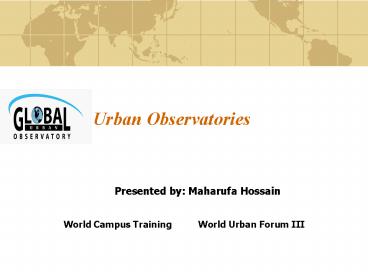Urban Observatories - PowerPoint PPT Presentation
1 / 6
Title:
Urban Observatories
Description:
State of the World Cities Report. Local capacity building. Local Urban Observatories ... support, LUO conducted a household survey to generate sub-city level ... – PowerPoint PPT presentation
Number of Views:86
Avg rating:3.0/5.0
Title: Urban Observatories
1
Urban Observatories
Presented by Maharufa Hossain World
Campus Training World Urban Forum III
2
Presentation outline
- Overview of Global Urban Observatory
- Local Urban Observatory (LUO)
- UN-HABITAT support for LUOs
- LUO case study
3
The Global Urban Observatory was established
after Habitat II in 1997
- In response to a decision of the United Nations
Commission on Human Settlements, which called for
a set mechanism to monitor global progress in
implementing the Habitat Agenda and to monitor
evaluate global urban conditions and trends.
4
What are the goals of GUO ?
- To help all partners monitor and evaluate urban
conditions and trends as measures of progress in
implementing the Habitat Agenda and MDGs - To help all partners use urban data in
participatory decision-making processes at all
levels
5
GUO key activities
- Global monitoring and reporting
- Global Urban Indicators Database
- Monitoring Urban Inequities Programme
- State of the World Cities Report
- Local capacity building
- Local Urban Observatories
- Local policy formulation
- Urban Info (Information Management System)
- 1000 cities GIS programme
6
The Urban Observatory Network levels
Local Urban Observatories (LUO) (city level)
7
Local Urban Observatories
City 2
LUO
City 1
City 3
NUO
City 4
City 5
LUOs are local platforms for policy information
at the city level, coordinated by National Urban
Observatories.
8
National Urban Observatories
NUOs are national platforms for policy
information at the country level, coordinated by
Global Urban Observatories.
9
What is a Local Urban Observatory?
- Develop, collect and analyze their own indicators
to monitor a range of local priority issues
e.g. social development, economic performance,
service delivery - Establish permanent mechanisms for monitoring
MDGs and Habitat Agenda indicators - Promote the use of urban data in planning and
policy-making at local and national level - Disseminate information to strengthen transparency
10
Local Urban Observatory Institutional Framework
- Usually housed in an existing city government
department (some cases NGO or university) - Network of data management
- Help catalyze new partnerships between
- National Statistical Office and local authority
- Different municipal departments
- Citizens and local authority
- Strong links with local policy-making processes
11
LUO responding to local demand
- Responding to need for improved data for planning
and monitoring of specific policies, sectors or
major programmes - Responding to citizen demand for better
information on government performance
12
Local Urban Observatory - skills
- Multi-sectoral Local Urban Observatory would
require staff from wide range of disciplines - Participation of senior policy-makers as users of
information - Statistical experts required for data collection
and analysis - Information Management expert for administering
Urban-Info system and spatial data analysis
(using GIS) - Communication experts for information
dissemination
13
Local Urban Observatory Key Products
- Integration of indicators in local development
plans and policies - Urban indicators database
- Studies, reports, policy recommendations, maps
- Information dissemination via newsletters,
TV/radio media-broadcasts, Internet, workshops,
etc
14
Local Urban Observatory Sustainability
- Political commitment
- Participatory mechanisms involving local
stakeholders - Resource commitments (budget and staff)
- Well-defined implementation framework (Action
Plan)
15
How to setup Urban Observatory
Phase 1 Inception and feasibility Assessment
Phase 2 Organizational Development
16
Case study Bangalore, India
- Objectives
- To develop a monitoring system to cover all key
operational activities of various municipal
departments in Bangalore - To recommend a strategy for integrating
indicators with city planning, monitoring and
management activities - To establish a Bangalore Local Urban Observatory
- Project implemented by GUOs regional partner
for Asia-Pacific, Society for Development
Studies, India
17
Case study Bangalore, India
- Stage 1. Identification and Selection of
Indicators - Indicators selected through a participatory
process involving inputs from key service
providers at city and state levels - Modules developed for various sectors Housing,
Urban Basic Services, Health and Environment,
Informal Sector, Social Development - Stage 2. Development of Database
- Data sources identified (e.g. census, agency
records, project reports of different donors,
research studies) - Data compiled from these various sources and
database developed - Estimations and projections made for years for
which data was unavailable
18
Case study Bangalore, India
- Stage 3. Analysis and Application
- Key sectors analyzed and Indicators-based
Planning Models developed for Housing, Water
Supply, Sanitation, Transport, Pollution, Solid
Waste Management - Policy recommendations made on the basis of
analysis - Stage 4. Capacity Building and Institutionalizatio
n - Capacity building needs of city officials
assessed - Officers of key agencies participated in 3 week
training program - Local Urban Observatory established within
Bangalore Metropolitan Regional Development
Authority
19
Case study Bangalore, India
- Need for more spatially-detailed information for
identifying, evaluating and prioritizing policy
issues - With World Bank support, LUO conducted a
household survey to generate sub-city level data
(sample size 3000hh) - Results used to develop recommendations on key
policy issues review of tariff structure for
water supply, improve access to water by reducing
distributional inequities.
20
Global Urban Observatory Support
- Financial assistance
- Training National, city programmes
- Tools indicators methodologies, guidelines,
case studies (Best Practice) - Urban-Info Software
- GIS software
- Networking international meetings
21
Thank you !

